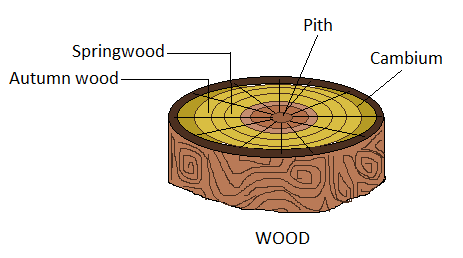Answer
396.9k+ views
Hint: Autumn wood is the result of secondary growth of xylem tissue in plants during the autumn or summer season. The autumn wood lies inward to summer wood and has thick walls around the vessels. On the other hand, the springwood has thin walls around vessels.
Complete answer: Large trees have wood which is the result of secondary growth in xylem which is a conductive tissue of the plant. Seasonal fluctuations affect the secondary growth of the xylem. Two types of wood are formed during different seasons. Springwood is formed during the spring season and summerwood is formed during the summer season.
-The springwood is characterized by numerous large vessels with a wider lumen. Springwood possesses a fewer number of fibers. So, springwood has a greater radial width as compared to summerwood. Springwood is also called earlywood.
-The secondary xylem growth that occurs during summer and autumn produces very less amount of growth. This is because of the highly reduced cambium activity. The summer or autumn wood has thick-walled vessels with a narrowed lumen. It mainly possesses fibers and narrow vessels. The autumn wood is also called latewood.

Both the springwood and autumn wood occurs in the form of concentric rings called annual rings. The annual rings are used to count the age of the plant. These rings form with each passing year of growth. One ring marks one growth season. But this is an approximate measure because seasonal conditions affect the ring formation. Also, latewood and earlywood have no color differences.
Thus, from the above discussion, we can conclude that option B is correct.
Note: During the spring season the trees have all the required necessities and thus rapid growth in secondary xylem occurs. But during the autumn or late season, colder conditions persist that slows down the growth of autumn wood. Thus, it is noticed that latewood is usually denser and darker.
Complete answer: Large trees have wood which is the result of secondary growth in xylem which is a conductive tissue of the plant. Seasonal fluctuations affect the secondary growth of the xylem. Two types of wood are formed during different seasons. Springwood is formed during the spring season and summerwood is formed during the summer season.
-The springwood is characterized by numerous large vessels with a wider lumen. Springwood possesses a fewer number of fibers. So, springwood has a greater radial width as compared to summerwood. Springwood is also called earlywood.
-The secondary xylem growth that occurs during summer and autumn produces very less amount of growth. This is because of the highly reduced cambium activity. The summer or autumn wood has thick-walled vessels with a narrowed lumen. It mainly possesses fibers and narrow vessels. The autumn wood is also called latewood.

Both the springwood and autumn wood occurs in the form of concentric rings called annual rings. The annual rings are used to count the age of the plant. These rings form with each passing year of growth. One ring marks one growth season. But this is an approximate measure because seasonal conditions affect the ring formation. Also, latewood and earlywood have no color differences.
Thus, from the above discussion, we can conclude that option B is correct.
Note: During the spring season the trees have all the required necessities and thus rapid growth in secondary xylem occurs. But during the autumn or late season, colder conditions persist that slows down the growth of autumn wood. Thus, it is noticed that latewood is usually denser and darker.
Recently Updated Pages
How many sigma and pi bonds are present in HCequiv class 11 chemistry CBSE

Why Are Noble Gases NonReactive class 11 chemistry CBSE

Let X and Y be the sets of all positive divisors of class 11 maths CBSE

Let x and y be 2 real numbers which satisfy the equations class 11 maths CBSE

Let x 4log 2sqrt 9k 1 + 7 and y dfrac132log 2sqrt5 class 11 maths CBSE

Let x22ax+b20 and x22bx+a20 be two equations Then the class 11 maths CBSE

Trending doubts
Fill the blanks with the suitable prepositions 1 The class 9 english CBSE

At which age domestication of animals started A Neolithic class 11 social science CBSE

Which are the Top 10 Largest Countries of the World?

Give 10 examples for herbs , shrubs , climbers , creepers

Difference between Prokaryotic cell and Eukaryotic class 11 biology CBSE

Difference Between Plant Cell and Animal Cell

Write a letter to the principal requesting him to grant class 10 english CBSE

Change the following sentences into negative and interrogative class 10 english CBSE

Fill in the blanks A 1 lakh ten thousand B 1 million class 9 maths CBSE



